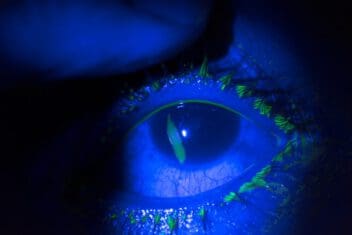
Medically Reviewed by Chirag R. Patel, M.D. NVISION Surgeon
Treatment for Mild and Severe Corneal Abrasions (A Guide)
Home / Eye Conditions & Eye Diseases / Scratched Cornea /
Last Updated:

Medically Reviewed by Chirag R. Patel, M.D. NVISION Surgeon
Corneal abrasions occur on the outermost layer (epithelium) of the cornea, called the corneal epithelium. These abrasions can be quite painful, make it difficult to look at light, cause heavy tearing, and blur your vision.
Table of Contents
Corneal abrasions are generally caused by foreign bodies that get into the eye, such as sand or dust.
If symptoms from your eye injury last more than a few minutes, it is a good idea to see a doctor. If you have extreme pain, foreign bodies can be seen in your eye, or even seemingly moderate symptoms persist, see a doctor as soon as possible.
Failing to properly treat an eye injury can lead to permanent damage, so it is better to be safe and get checked.
What a doctor decides is best for you will depend largely on your injury. Perhaps most important will be checking for foreign bodies — any debris that has lodged into your eye. These foreign bodies can cause serious damage and introduce bacteria to the wound, so they must be removed by a trained professional as soon as possible.
Even for less serious injuries, the doctor will probably want to check in once or twice more to see how your eye is healing.
To avoid corneal abrasions, wear protective eyewear when performing activities where debris or other materials might be at risk of hitting your eye. Additionally, be sure to keep the fingernails of infants and young children short, so they do not accidentally scratch their own eyes.
Treatment Options

The treatment for corneal abrasions has evolved a bit over the years.
It used to be quite common that an eye would be patched to protect it as it healed, but this has been found to often be ineffective and even detrimental for corneal abrasions. Patches are only now prescribed for very specific purposes, such as to help keep children and people with certain mental health issues from rubbing their injuries. They are also sometimes used for especially serious abrasions.
A mild corneal abrasion may not need much in the way of treatment, although making sure a doctor looks at it and checks for any foreign bodies will help to prevent complications. More severe corneal abrasions may require medications or further treatment.
Some topical medications might be used. Topical analgesics (pain relievers) are relatively common to manage any pain the eye injury causes. The necessity and effectiveness of antibiotics for corneal abrasions are sometimes questioned, but they have been shown to help prevent further complications in at least some cases.
With corneal abrasions, you usually should get evaluated again 24 hours after you first see the doctor, so they can check for any change. If the injury has not fully healed in that time, your doctor should see you again in three to four days to monitor healing and check for any complications.
If you wear contact lenses, you should return to your doctor in 24 hours and then again after three to four days even if you feel completely well. Contact lenses can complicate eye injuries, as they rest directly on the eye.
Do not rub an injured eye when it is healing. Additionally, you should discuss wearing contacts with your doctor before doing so. If you have glasses, it is likely a good idea to switch to using them until your eyes are fully healed.
For severe corneal abrasions, a doctor may need to remove the foreign object from the eye. Prompt treatment is necessary to prevent permanent damage to the eye.
What is a Corneal Abrasion?

Corneal abrasions represent about 8 percent of eye injuries that are serious enough for someone to seek help from a doctor.
A corneal abrasion occurs when the corneal epithelium, the outermost layer of the cornea (the lens of your eye that is key to seeing), is scratched or otherwise damaged.
You deserve clear vision. We can help.
With 135+ locations and over 2.5 million procedures performed, our board-certified eye surgeons deliver results you can trust.
Your journey to better vision starts here.
Signs of a Corneal Abrasion

A few of the major signs of a corneal abrasion include:
- Serious eye pain, especially after an injury or feeling debris enter the eye.
- Photophobia (pain caused by bright or even mild light).
- Heavy tearing.
- Foreign body sensation (the feeling of something on the eye when you blink or move your eye).
- Blurred vision.
Usually, you will be able to pinpoint roughly when your injury occurred, such as when mining stone or playing a sport, but if it was caused by something in your sleep or by lightly rubbing your eyes, you may not know what caused your abrasion.
The pain caused by a corneal abrasion may seem disproportionate to the level of damage that actually occurs. The eye is full of nerve cells, with hundreds of times more pain receptors than your skin. This helps to avoid injuring our sensitive eyes, but it can also mean eye injuries are quite painful if we do end up hurting them.
Causes of Corneal Abrasions
The damage that results in a corneal abrasion is usually caused by some kind of trauma, like sand or other debris getting into the eye. It is a relatively common occurrence for people who are in industries such as mining or woodworking, where debris is common. It can also happen to children playing sports.
Corneal abrasions commonly result from accidentally scratching your eye with a fingernail or edge of paper. Even makeup brushes frequently cause corneal abrasions.
A contact lens can also cause a scratch when you rub your eye. Oftentimes, a corneal abrasion might result from a seemingly light eye rub.
You deserve clear vision. We can help.
With 135+ locations and over 2.5 million procedures performed, our board-certified eye surgeons deliver results you can trust.
Your journey to better vision starts here.
When to See a Doctor
Many patients who come in for corneal abrasions can point to the event that started their trouble. There are many things that can cause a corneal abrasion, but a good rule of thumb is that if your eye hurts for more than a few minutes or if your sight appears to be seriously affected, your injury should probably be looked at by a doctor as soon as possible to prevent any further or permanent damage.
While it is true many corneal abrasions can heal on their own, eye injuries can be fairly serious. If any foreign material got into your eye, even if you do not have a foreign body sensation, it can cause further injury unless removed by a professional.
Additionally, if your abrasion is particularly deep, it can cause even more problems and will take longer to heal. It is usually a good idea to be evaluated by a doctor to get a professional medical opinion on your injury. Sometimes, the doctor may refer you to an ophthalmologist or similar specialist if your injury seems serious.
Severe Corneal Abrasions

A mild corneal abrasion will generally heal in one or two days, which is why it is recommended to be reevaluated by a doctor after 24 hours for such injuries. Again, a mild corneal abrasion may not need treatment other than observation.
A severe corneal abrasion can take three days or slightly longer to heal. While it is a good idea to see a doctor for any corneal abrasion, a severe corneal abrasion could lead to permanent damage.
It is likely that you will need to go to an ophthalmologist to deal with a severe corneal abrasion, especially if foreign bodies need to be removed from your eye. Additionally, your risk of further complications is linked to the severity of the injury.
Sight can be permanently damaged if the corneal epithelium scars heavily. Deep scratches can cause it to be necessary to receive a corneal transplant for improvement. It is also possible for deep scratches to become infected, which is why topical antibiotics are sometimes prescribed.
Prevention
Keeping fingernails, particularly the fingernails of children and infants, short can reduce the likelihood of scratching the eyes if they are rubbed or accidentally touched.
People who engage in any activity where there is a risk of debris or eye injury should wear protective eyewear. It should be noted that regular eyewear does not provide sufficient protection.
You deserve clear vision. We can help.
With 135+ locations and over 2.5 million procedures performed, our board-certified eye surgeons deliver results you can trust.
Your journey to better vision starts here.
References
- Management of Corneal Abrasions. (July 1, 2004). American Academy of Family Physicians.
- Evaluation and Management of Corneal Abrasions. (January 15, 2013). American Academy of Family Physicians.
- What Is Corneal Abrasion? (April 9, 2019). American Academy of Ophthalmology.
- Corneal Abrasion. (January 2019). Harvard Medical School.
- What Is a Corneal Abrasion? WebMD.
- Corneal Abrasion. (March 2015). Cleveland Clinic.
- Size, Severity of Injury, Level of Pain Determine Treatment for Corneal Abrasion. (December 1999). Healio.

Chirag R. Patel, M.D. specializes in the diagnosis and treatment of diseases of the cornea, anterior segment, and lens.
This content is for informational purposes only. It may have been reviewed by a licensed physician, but is not intended to serve as a substitute for professional medical advice. Always consult your healthcare provider with any health concerns. For more, read our Privacy Policy and Editorial Policy.
